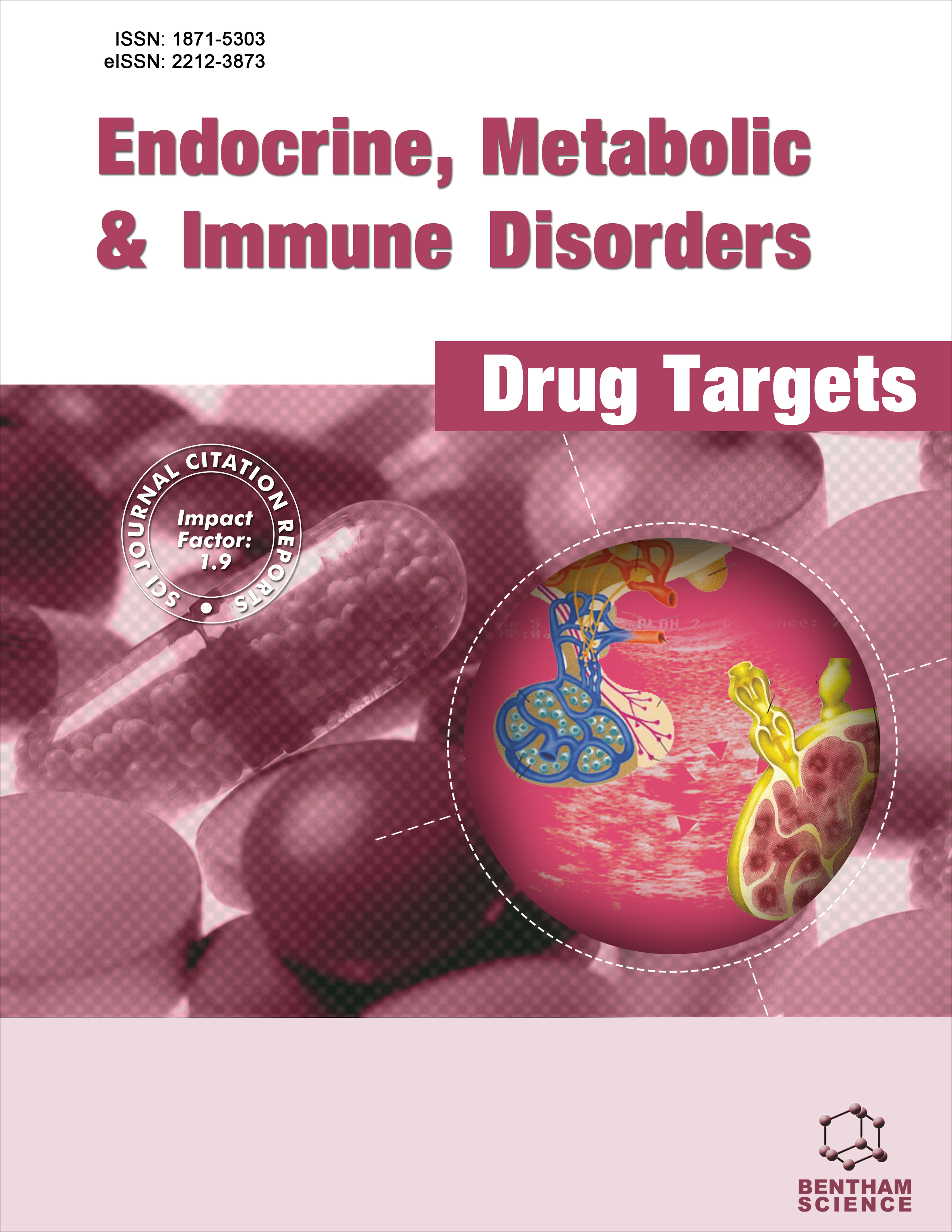- Home
- A-Z Publications
- Endocrine, Metabolic & Immune Disorders-Drug Targets (Formerly Current Drug Targets - Immune, Endocrine & Metabolic Disorders)
- Previous Issues
- Volume 24, Issue 11, 2024
Endocrine, Metabolic & Immune Disorders-Drug Targets (Formerly Current Drug Targets - Immune, Endocrine & Metabolic Disorders) - Volume 24, Issue 11, 2024
Volume 24, Issue 11, 2024
-
-
Study Deciphering the Crucial Involvement of Notch Signaling Pathway in Human Cancers
More LessAuthors: Pratibha Pandey, Fahad Khan, Megha Singh, Aditi verma, Hariom Kumar, Avijit Mazumder and Gurmeen RakhraIn recent years, dysregulation of the notch pathway has been associated with the development and progression of various cancers. Notch signaling is involved in several cellular processes, such as proliferation, differentiation, apoptosis, and angiogenesis, and its abnormal activation can lead to uncontrolled cell growth and tumorigenesis. In various human cancers, the Notch pathway has been shown to have both tumor-promoti Read More
-
-
-
Moroccan Antihypertensive Plants and their Mechanisms of Action
More LessAuthors: Smail Amtaghri, Miloudia Slaoui and Mohamed EddouksBackground: The use of herbal remedies, medicinal plants, and their derivatives for the treatment and control of hypertension is well-known and widespread throughout Morocco. Aims: The aim of the study was to review the antihypertensive and vasorelaxant medicinal plants of the Moroccan pharmacopeia. Objective: To date, no review on Moroccan medicinal plants exhibiting antihypertensive effects has been performed, and Read More
-
-
-
The Application of Artificial Intelligence in Thyroid Nodules: A Systematic Review Based on Bibliometric Analysis
More LessAuthors: Yun Peng, Tong-Tong Wang, Jing-Zhi Wang, Heng Wang, Ruo-Yun Fan, Liang-Geng Gong and Wu-Gen LiBackground: Thyroid nodules are common lesions in benign and malignant thyroid diseases. More and more studies have been conducted on the feasibility of artificial intelligence (AI) in the detection, diagnosis, and evaluation of thyroid nodules. The aim of this study was to use bibliometric methods to analyze and predict the hot spots and frontiers of AI in thyroid nodules. Methods: Articles on the application of artificial intelli Read More
-
-
-
Insight into the Predictive Power of Surrogate Diagnostic Indices for Identifying Individuals with Metabolic Syndrome
More LessBackground: This study aimed to assess the diagnostic capability of insulin surrogate measurements in identifying individuals with metabolic syndrome (MetS) and propose applicable indices derived from fasting values, particularly in large study populations. Methods: Data were collected from the datasets of the Surveillance of Risk Factors of NCDs in Iran Study (STEPS). MetS was defined based on the National Cholesterol Read More
-
-
-
Highlights from the Top 100 Most Influential Articles Regarding the Nuclear Receptor PPAR-γ: A Bibliometric Analysis
More LessAuthors: Si Wu, Haijiao Dai, Xianxiang Bai, Zhen Wu, Xianglei Wang and Bin XiaoBackground: PPAR-γ is one of three members of the PPAR group of the nuclear receptor superfamily and plays an important regulatory role as a ligand-dependent transcription factor. Objective: This study aimed to identify the top 100 most influential articles in the field of PPAR-γ. We hypothesized that a bibliometric and scientometric analysis of the PPAR-γ research field could render trends that provide researchers an Read More
-
-
-
The Levels of Phoenixin-14 and Phoenixin-20 in Patients with Type 2 Diabetes Mellitus
More LessAuthors: Ummugulsum Can, Sadinaz Akdu and Serdar ŞahinoğluBackground: New pathogenesis-related early detection markers are needed to prevent Type 2 Diabetes Mellitus (T2DM). Objective: We aimed to determine phoenixin (PNX)-14 and PNX-20 levels in T2DM patients and investigate their relationship with diabetes. Methods: 36 T2DM patients and 36 healthy controls were included in the study, and PNX-14 and PNX-20 levels in blood samples taken from the groups were measured b Read More
-
-
-
Is Kidney Stone Associated with Thyroid Disease? The United States National Health and Nutrition Examination Survey 2007-2018
More LessAuthors: Wenya Xue, Zihan Xue, Yanbing Liu, Pan Yin, Luyu Liu, Shen'ao Qu, Shaobo Wu and Chuance YangBackground: Kidney stones and thyroid disease are two common diseases in the general population, with multiple common risk factors. The associations between kidney stones and thyroid disease are unclear. Aim: This study aims to assess the association between ‘once had a thyroid disease’ and the odds of kidney stones. Methods: Adult participants from the National Health and Nutrition Examination Survey (NHANES Read More
-
-
-
Could the Propionic Acid Treatment in Combination with Metformin be Safe for the Small Intestine of Diabetic Rats?
More LessAuthors: Larysa Natrus, Olha Lisakovska, Anton Smirnov, Yuliia Osadchuk, Serhyi Savosko and Yuliia KlysBackground: Effects of propionic acid (PA) on the cellular and molecular processes in the small intestine under type 2 diabetes mellitus (T2DM)-induced endoplasmic reticulum (ER) stress remain incompletely studied. Objectives: The aim of the study was to assess the state of unfolded protein response (UPR) system in the small intestine of diabetic rats and to explore PA’s influence on metformin treatment. Methods: Ma Read More
-
-
-
A Case of Intractable Hypophosphatemia in a Patient with Guillain-Barré Syndrome and Encephalitis after SARS-CoV-2 Infection
More LessAuthors: Yawen Zheng, Yuanyuan Hou, Mingzhu Qi, Yongxiang Zhang, Chao Han, Hui Sun and Jiang LiBackground: Severe acute respiratory syndrome coronavirus 2 (SARS-CoV-2) infection attacks the respiratory and nervous systems. Among patients with SARS-CoV-2 infection, cases with simultaneous central and peripheral nervous system damage are rare, and those with intractable hypophosphatemia and hypokalemia complicating the former have not been reported yet. Case Presentation: A 59-year-old woman pre Read More
-
Volumes & issues
-
Volume 25 (2025)
-
Volume 24 (2024)
-
Volume 23 (2023)
-
Volume 22 (2022)
-
Volume 21 (2021)
-
Volume 20 (2020)
-
Volume 19 (2019)
-
Volume 18 (2018)
-
Volume 17 (2017)
-
Volume 16 (2016)
-
Volume 15 (2015)
-
Volume 14 (2014)
-
Volume 13 (2013)
-
Volume 12 (2012)
-
Volume 11 (2011)
-
Volume 10 (2010)
-
Volume 9 (2009)
-
Volume 8 (2008)
-
Volume 7 (2007)
-
Volume 6 (2006)
Most Read This Month
Article
content/journals/emiddt
Journal
10
5
false
en


